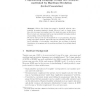Free Online Productivity Tools
i2Speak
i2Symbol
i2OCR
iTex2Img
iWeb2Print
iWeb2Shot
i2Type
iPdf2Split
iPdf2Merge
i2Bopomofo
i2Arabic
i2Style
i2Image
i2PDF
iLatex2Rtf
Sci2ools
106
click to vote
SAS
2007
Springer
2007
Springer
Programming Language Design and Analysis Motivated by Hardware Evolution
Abstract. Silicon chip design has passed a threshold whereby exponentially increasing transistor density (Moore’s Law) no longer translates into increased processing power for single-processor architectures. Moore’s Law now expresses itself as an exponentially increasing number of processing cores per fixed-size chip. We survey this process and its implications on programming language design and static analysis. Particular aspects addressed include the reduced reliability of ever-smaller components, the problems of physical distribution of programs and the growing problems of providing shared memory. 1 Hardware Background Twenty years ago (1985 to be more precise) it was all so easy—processors and matching implementation languages were straightforward. The 5-stage pipeline of MIPS or SPARC was well established, the 80386 meant that the x86 architecture was now also 32-bit, and memory (DRAM) took 1–2 cycles to access. Moreover ANSI were in the process of standardising C which p...
Related Content
| Added | 09 Jun 2010 |
| Updated | 09 Jun 2010 |
| Type | Conference |
| Year | 2007 |
| Where | SAS |
| Authors | Alan Mycroft |
Comments (0)

